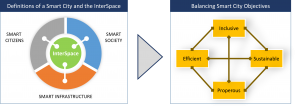“… Our culture, our prosperity, and our freedom are all ultimately gifts of people living, working, and thinking together – the ultimate triumph of the city”. — Edward Gleaser, 2012
Introduction
Since its conception by Big Tech companies e.g. IBM and Cisco at the end of 00’s, the Smart Cities concept has had a tremendous uptake, but has also taken on many shapes, forms and meanings. It is fair to say that the concept has become an “anything goes” notion, and as such stands the risk of losing its relevance. However, given the many exciting new initiatives with similar labels e.g. Resilient, BOLD, or Future Cities, it is clear that the notion of a Smart City resonates with some of the issues of our time and is here to stay. It is time for a new encompassing definition and an update on the raison d’ etre of Smart Cities. We will do so by first explaining the importance of cities and the reason why we are attaching to word “smart” to them.
About Cities
Cities first emerged some 6000 years ago in Mesopotamia, and as such cities are a relatively recent phenomenon given that home sapiens roams the earth for about 300.000 years. The word city comes from the Latin word “civitas” meaning civilisation, implying that the emergence of cities marks the beginning of humanities’ great accomplishments and flourishing. Cities are indeed the driving forces of economic development, innovation and collaboration. Edward Gleaser (2012) has heralded the city as humanities’ greatest invention. In a similar vein Lewis Mumford (1961) gives a more poetic description of the purpose of cities: “The great function of the city is to encourage and incite the greatest possible number of meetings, encounters, and challenges between all persons, classes and groups, providing a stage upon which the drama of social life may be enacted with the actors taking their turns as spectators and the spectators as actors.” Or, as put more succinctly by Matt Ridley (2012): “Cities are places where ideas have sex”.
But the city is not only a story of glory and triumph, the city is also the place where many of humanities grand challenges – e.g. pollution, crime, crossing planetary boundaries, inequality – occur and where they can be solved. Today 50% of the world’s population lives in cities, and the UN expects that this number will rise to 70% by 2050. Cities account for 80% of our carbon-dioxide emissions and consume 75% of the earth’s natural resources. Changing populations due to ageing and migration, increasing pressure on urban infrastructures, and ever present safety and security threats are just some of the many problems facing cities.
The technology making Cities “Smart”
The promise of a Smart City is that we can use technology to cope with these grand challenges. As Digital Technologies are profoundly changing the way we live, work and organise it is believed by many that we are on the verge of the 4th industrial revolution. Technologies such as artificial intelligence (AI), big data, the internet-of-things (IoT), robotics, mobile, social, cloud computing, and blockchain are creating four underlying forces shaping our digital age: hyper-connectivity, hyper-intelligence, pervasiveness, and virtualisation. It is the confluence of these forces that makes digitisation so disruptive. This disruptive nature means that these rapidly developing technologies are both feared and revered.
The fear includes concerns like losing our jobs to AI and robots, losing our privacy to “big brother”, and losing control over algorithms that may run amok or even worse, have prejudices that go unnoticed. The fact that this technology is dominated by a handful of Big Tech companies that are getting very powerful calls for countervailing power by governments and vigilance of users, both of which are uphill battles. The admiration for this technology comes from the fact that digitisation enables us to have a far better sense of what is happening in the world – in real time – and helps us to predict and prevent incidents. It enables us to develop better services and creates many new economic opportunities. Its ever decreasing cost and distributed nature makes this technology available to everyone and is therefore seen to foster democracy. And last but not least, once we have convinced ourselves not to “compete against machines, but compete with machines” this technology promises to compensate our weaknesses and “augment our humanity”.
A new and encompassing definition of Smart City
So how do we keep, given the dilution of the smart city concept and its co-existing dystopian and utopian views, the conversation moving forward? By, first of all, refreshing the definition of the Smart City to encompass its many aspects. And secondly, by ensuring that our approach to creating Smart Cities is neither conservative nor overly optimistic, but realistic and comprehensive. An approach of Disciplined Imagination.
In our view a Smart City has evolved from a concept denoting only Smart Infrastructure to a comprehensive concept comprising three interrelated subsystems: Smart Infrastructure, Smart Citizens, and Smart Society. Smart Infrastructure refers to the use of digital technologies, including sensors, networks and algorithms, to build and maintain city infrastructure in a more efficient way. Smart grids, smart mobility and smart waste systems are just a few examples of Smart Infrastructure. With Smart Citizens we mean that citizens behave responsibly, are well educated and healthy, and engage and participate in the social and democratic top-down and bottom-up processes of a city. Finally, a Smart Society refers to a political, economic and social system in a city that makes optimal use of digital technologies for governance, innovation, participation, collaboration and the creation of wealth and wellbeing for all. As mentioned these components cannot be seen separate from each other as denoted in the following formula:
Smart City = Smart Infrastructure x Smart Citizens x Smart Society
The multiplicative (and not additive) effect in this equation is enabled by advances in digitisation e.g. cloud, social and mobile technologies, and hence the real reason why a well-designed city becomes truly “Smart”.
The InterSpace
To model this multiplicative effect we introduce the construct of the InterSpace. This notion is a convolution of the terms “interface” and “space” and denotes the physical-virtual interface through which people, things and organisations in a Smart City interact and influence each other’s behaviour. Examples are piano stairs that nudge people to use the stairs, car speed measurement displays alongside roads, and smart billboards that respond to the person standing in front of them.
Since its early conception Smarter City was seen as a “system of (infrastructural) systems”. And although many projects are taking off in the various sectors e.g. Energy, Public Safety or Mobility, the promise of a holistic approach is hardly ever fulfilled. Urban Platforms and Operations centers come close but lack the vision of the InterSpace to grow into more than a hub. Maybe because we are trying to envision something new by using old “building blocks”, i.e. sectors.
If we take a different view, and not take sectors but humans and things and their behaviour as building blocks, we may get the new perspective we are looking for in search for innovative solutions. The concept of InterSpace is an emerging living, intelligent and adaptive system of mixed virtual-and-physical reality. Intelligence is gained by combining data emanating from all three subsystems feeding the InterSpace. Things, people and organisations interact and influence each other’s behaviour thru stimuli e.g. information, nudges and physical signals. The distinction between the physical and virtual worlds disappears in the InterSpace and the stimuli help create the systemic behaviour that moves the Smart City toward achieving its objectives.
Disciplined Imagination as an approach to reach Smart City Objectives
In a smart city digitisation helps the city to reach its objectives of becoming efficient, sustainable, prosperous and inclusive. These four objectives of a city, be it smart or not, are to be pursued in a balanced way – it is the combination of objectives that makes a city thrive.
Furthermore Smart Cities thrive if we adhere to a three pronged approach. First of all, we keep the conversation comprehensive and avoid the trap of reverting back to thinking in silos. In our networked world where everything influences everything, the construct of the InterSpace helps us to understand this entanglement and design truly Smart Cities. Secondly, we solve wicked problems using the quadruple helix, i.e. we ensure the involvement and collaboration of governments, businesses, knowledge institutions and citizens (directly or thru civic organisations). And finally, we view technology not as a technocratic goal in itself, nor as a mere enabler, but as one of the major drivers of change, next to Globalisation and Sustainability. The 4th industrial revolution is changing human behaviour and the possibilities to improve our lives and circumstances are endless. But we do need a deep understanding of the underlying technological and societal forces and apply our Disciplined Imagination.
Relevance regained
We need the concept of a Smart City as described here because cities are the “crucibles” where we can tackle wicked problems and because urbanisation is expected to grow exponentially for many years ahead. The role of an encompassing Smart City concept as defined in this article is threefold. First of all it gives us a world view that allows us to keep improving our discourse (Haijer, 2014) about the dynamics of cities. Secondly, it forces us to shift our paradigm away from silo-thinking which is highly inappropriate – if not disastrous – in a networked world. And lastly, the Smart Cities concept gives us a model to use for (re)designing and managing our cities.
Concluding Remarks
Since their emergence some 6000 years many cities have come and gone. History teaches us that cities die from either natural disaster, war, depletion of natural resources, or changes in the economy. The demise of for instance the great Mayan cities, believed to be caused by unsustainability of resource use and societal hierarchy, and the demise of Petra caused by a change in trade routes, hold many lessons for today’s cities and we better take notice.
Digitisation holds the promise of preventing demise from happening to our cities today. But let’s be aware that technology is a double edged sword that can be used for good and for bad. If this article leaves you with only one message, it is that the city is not going to become smart all by itself. Engagement, thru deliberate concerted action, is needed from all stakeholders in the quadruple helix, but first and foremost from citizens. So if the city, like Lewis says, is a stage on which the drama of life is enacted, we each need to ask ourselves: “Which role will I play as an actor – and not mere spectator – to make our world a better place?”

